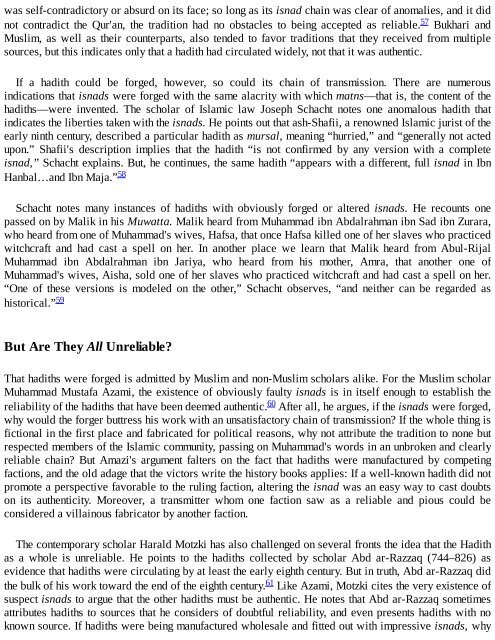robert spencer-did muhammad exist__ an inquiry into islams obscure origins-intercollegiate studies institute (2012) (1)
You also want an ePaper? Increase the reach of your titles
YUMPU automatically turns print PDFs into web optimized ePapers that Google loves.
was self-contradictory or absurd on its face; so long as its isnad chain was clear of <strong>an</strong>omalies, <strong>an</strong>d it <strong>did</strong><br />
not contradict the Qur'<strong>an</strong>, the tradition had no obstacles to being accepted as reliable. 57 Bukhari <strong>an</strong>d<br />
Muslim, as well as their counterparts, also tended to favor traditions that they received from multiple<br />
sources, but this indicates only that a hadith had circulated widely, not that it was authentic.<br />
If a hadith could be forged, however, so could its chain of tr<strong>an</strong>smission. There are numerous<br />
indications that isnads were forged with the same alacrity with which matns—that is, the content of the<br />
hadiths—were invented. The scholar of Islamic law Joseph Schacht notes one <strong>an</strong>omalous hadith that<br />
indicates the liberties taken with the isnads. He points out that ash-Shafii, a renowned Islamic jurist of the<br />
early ninth century, described a particular hadith as mursal, me<strong>an</strong>ing “hurried,” <strong>an</strong>d “generally not acted<br />
upon.” Shafii's description implies that the hadith “is not confirmed by <strong>an</strong>y version with a complete<br />
isnad,” Schacht explains. But, he continues, the same hadith “appears with a different, full isnad in Ibn<br />
H<strong>an</strong>bal…<strong>an</strong>d Ibn Maja.” 58<br />
Schacht notes m<strong>an</strong>y inst<strong>an</strong>ces of hadiths with obviously forged or altered isnads. He recounts one<br />
passed on by Malik in his Muwatta. Malik heard from Muhammad ibn Abdalrahm<strong>an</strong> ibn Sad ibn Zurara,<br />
who heard from one of Muhammad's wives, Hafsa, that once Hafsa killed one of her slaves who practiced<br />
witchcraft <strong>an</strong>d had cast a spell on her. In <strong>an</strong>other place we learn that Malik heard from Abul-Rijal<br />
Muhammad ibn Abdalrahm<strong>an</strong> ibn Jariya, who heard from his mother, Amra, that <strong>an</strong>other one of<br />
Muhammad's wives, Aisha, sold one of her slaves who practiced witchcraft <strong>an</strong>d had cast a spell on her.<br />
“One of these versions is modeled on the other,” Schacht observes, “<strong>an</strong>d neither c<strong>an</strong> be regarded as<br />
historical.” 59<br />
But Are They All Unreliable?<br />
That hadiths were forged is admitted by Muslim <strong>an</strong>d non-Muslim scholars alike. For the Muslim scholar<br />
Muhammad Mustafa Azami, the <strong>exist</strong>ence of obviously faulty isnads is in itself enough to establish the<br />
reliability of the hadiths that have been deemed authentic. 60 After all, he argues, if the isnads were forged,<br />
why would the forger buttress his work with <strong>an</strong> unsatisfactory chain of tr<strong>an</strong>smission? If the whole thing is<br />
fictional in the first place <strong>an</strong>d fabricated for political reasons, why not attribute the tradition to none but<br />
respected members of the Islamic community, passing on Muhammad's words in <strong>an</strong> unbroken <strong>an</strong>d clearly<br />
reliable chain? But Amazi's argument falters on the fact that hadiths were m<strong>an</strong>ufactured by competing<br />
factions, <strong>an</strong>d the old adage that the victors write the history books applies: If a well-known hadith <strong>did</strong> not<br />
promote a perspective favorable to the ruling faction, altering the isnad was <strong>an</strong> easy way to cast doubts<br />
on its authenticity. Moreover, a tr<strong>an</strong>smitter whom one faction saw as a reliable <strong>an</strong>d pious could be<br />
considered a villainous fabricator by <strong>an</strong>other faction.<br />
The contemporary scholar Harald Motzki has also challenged on several fronts the idea that the Hadith<br />
as a whole is unreliable. He points to the hadiths collected by scholar Abd ar-Razzaq (744–826) as<br />
evidence that hadiths were circulating by at least the early eighth century. But in truth, Abd ar-Razzaq <strong>did</strong><br />
the bulk of his work toward the end of the eighth century. 61 Like Azami, Motzki cites the very <strong>exist</strong>ence of<br />
suspect isnads to argue that the other hadiths must be authentic. He notes that Abd ar-Razzaq sometimes<br />
attributes hadiths to sources that he considers of doubtful reliability, <strong>an</strong>d even presents hadiths with no<br />
known source. If hadiths were being m<strong>an</strong>ufactured wholesale <strong>an</strong>d fitted out with impressive isnads, why


